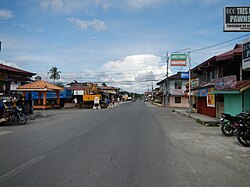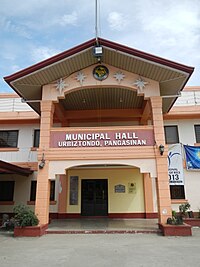Urbiztondo
Urbiztondo | |
|---|---|
 Street in Urbiztondo | |
OpenStreetMap | |
| Country | Philippines |
| Named for | Juan Antonio de Urbiztondo |
| Barangays | (see Barangays) |
| Government | |
| • Mayor | Martin Raul S. Sison II |
| • Vice Mayor | Marilyn S. Sison |
| • Representative | Jumel Anthony I. Espino |
| • Councilors | Members |
| • Electorate | voters (?) |
| Highest elevation | 30 m (100 ft) |
| Lowest elevation | 6 m (20 ft) |
| Economy | |
| • Poverty incidence | % (?) |
| Service provider | |
| • Electricity | — |
| Time zone | UTC+8 (PST) |
| PSGC | PSGC unknown |
Urbiztondo, officially the Municipality of Urbiztondo (Pangasinan: Baley na Urbiztondo; Ilocano: Ili ti Urbiztondo; Tagalog: Bayan ng Urbiztondo), is a 3rd class municipality in the province of Pangasinan, Philippines. According to the 2020 census, it has a population of 55,557 people. [3]
History
The municipality was named after Spanish governor-general General Antonio de Urbiztondo y Villasis who acted as Spanish Governor in the Philippines and was also conqueror of the Muslims in Jolo from 1850 to 1852. He then issued a decree founding the town and consequently the newly formed town was named “Urbiztondo” in his honor. The Municipality of Urbiztondo's establishment as a town was primarily due to Fr. Ramon Dalmau, the parish priest of San Carlos, who began its foundation in 1852, separating the said town from San Carlos now a city. The initiative in the emergence of Urbiztondo came from the pioneering fathers from San Carlos, Pangasinan. Its creation has been credited to Rev. Father Ramon Dalmau, curate of San Carlos who worked hard for its founding on November 28, 1853. It remained a visita of San Carlos in the year 1852. It was separated from San Carlos on the above date when it was assigned its own curate. The Dominicans accepted Urbiztondo as a vicariate in 1855 designating Rev. Father Francisco Treserra who is also responsible for relocating the town to the place where it is now located.
Geography
Barangays
Urbiztondo is politically subdivided into 21 barangays. These barangays are headed by elected officials: Barangay Captain, Barangay Council, whose members are called Barangay Councilors. All are elected every three years.
- Angatel
- Balangay
- Batangcaoa
- Baug
- Bayaoas
- Bituag
- Camambugan
- Dalanguiring
- Duplac
- Galarin
- Gueteb
- Malaca
- Malayo
- Malibong
- Pasibi East
- Pasibi West
- Pisuac
- Poblacion
- Real
- Salavante
- Sawat
Climate
| Climate data for Urbiztondo, Pangasinan | |||||||||||||
|---|---|---|---|---|---|---|---|---|---|---|---|---|---|
| Month | Jan | Feb | Mar | Apr | May | Jun | Jul | Aug | Sep | Oct | Nov | Dec | Year |
| Average high °C (°F) | 31 (88) |
32 (90) |
33 (91) |
34 (93) |
33 (91) |
32 (90) |
31 (88) |
30 (86) |
31 (88) |
32 (90) |
32 (90) |
31 (88) |
32 (89) |
| Average low °C (°F) | 22 (72) |
23 (73) |
24 (75) |
25 (77) |
25 (77) |
25 (77) |
25 (77) |
25 (77) |
25 (77) |
24 (75) |
24 (75) |
23 (73) |
24 (75) |
| Average precipitation mm (inches) | 9 (0.4) |
11.4 (0.45) |
11.1 (0.44) |
5.4 (0.21) |
258 (10.2) |
315.6 (12.43) |
463.1 (18.23) |
663.2 (26.11) |
479.7 (18.89) |
121.9 (4.80) |
75.8 (2.98) |
16.8 (0.66) |
2,431 (95.8) |
| Average rainy days | 4 | 3 | 2 | 2 | 12 | 15 | 19 | 21 | 18 | 12 | 9 | 5 | 122 |
| Source: World Weather Online[4] | |||||||||||||
Demographics
| Year | Pop. | ±% p.a. |
|---|---|---|
| Source: Philippine Statistics Authority [5] [6] [7] | ||
Economy
Government
Urbiztondo, belonging to the second congressional district of the province of Pangasinan, is governed by a mayor designated as its local chief executive and by a municipal council as its legislative body in accordance with the Local Government Code. The mayor, vice mayor, and the councilors are elected directly by the people through an election which is being held every three years.
Elected officials
| Position | Name |
|---|---|
| Congressman | Jumel Anthony I. Espino |
| Mayor | Martin Raul S. Sison II |
| Vice-Mayor | Marilyn S. Sison |
| Councilors | Volter D. Balolong |
| Dyna P. De Guzman | |
| Edwin T. Tamondong | |
| Pepito N. Calugay | |
| Danilo M. Tamondong | |
| Brandy M. Palisoc | |
| Vicente A. Frias Jr. | |
| Jordan Melcho V. Palisoc |
References
- ^
- ^ "2015 Census of Population, Report No. 3 – Population, Land Area, and Population Density" (PDF). Philippine Statistics Authority. Quezon City, Philippines. August 2016. ISSN 0117-1453. Archived (PDF) from the original on May 25, 2021. Retrieved July 16, 2021.
- ^ a b Census of Population (2020). Table B - Population and Annual Growth Rates by Province, City, and Municipality - By Region. PSA. Retrieved 8 July 2021.
- ^ "Urbiztondo, Pangasinan: Average Temperatures and Rainfall". World Weather Online. Retrieved 31 October 2015.
- ^ Census of Population (2015). Highlights of the Philippine Population 2015 Census of Population. PSA. Retrieved 20 June 2016.
- ^ Census of Population and Housing (2010). Population and Annual Growth Rates for The Philippines and Its Regions, Provinces, and Highly Urbanized Cities (PDF). NSO. Retrieved 29 June 2016.
- ^ Censuses of Population (1903–2007). Table 1. Population Enumerated in Various Censuses by Region: 1903 to 2007. NSO.
- ^ "2019 National and Local Elections" (PDF). Commission on Elections. Retrieved March 6, 2022.
{{cite web}}: CS1 maint: url-status (link)
External links
- Urbiztondo Profile at PhilAtlas.com
- Municipal Profile at the National Competitiveness Council of the Philippines
- Urbiztondo at the Pangasinan Government Website
- Local Governance Performance Management System
- String Module Error: String subset index out of range000®code=String Module Error: String subset index out of range&provcode=String Module Error: String subset index out of range Philippine Standard Geographic Code
- Philippine Census Information
- Pages using the Graph extension
- CS1 maint: url-status
- Articles with short description
- Short description with empty Wikidata description
- Pages using PH wikidata incorrectly
- Philippine articles requiring maintenance
- Pages using infobox settlement with image map1 but not image map
- Pages using infobox settlement with no coordinates
- Articles containing Pangasinan-language text
- Articles containing Ilocano-language text
- Articles containing Tagalog-language text
- Commons category link is the pagename
- Errors reported by Module String
- AC with 0 elements
- Municipalities of Pangasinan
- Populated places on the Agno River
- All stub articles
- Philippines geography stubs
